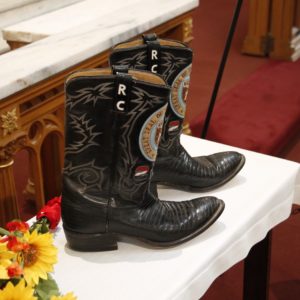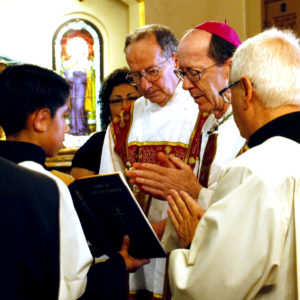Friends and family of the first Hispanic governor of Arizona gathered at St. Mary’s Basilica May 16 to bid farewell to Raúl Héctor Castro.
The 98-year-old former diplomat rose from poverty and suffered discrimination before making his mark in history. His family emigrated from Mexico when he was 10 years old. After his father died, his mother was left to raise 12 children in poverty.
Gerry Emmett, 100, recalled meeting Castro when they both attended Arizona Teachers College in Flagstaff, each of them scholarship students.
“I called him the Knockout Kid,” Emmett said following the Mass. Both Castro and Emmett earned teaching degrees, she said. “I got a good job, but Raúl got no job because he was Hispanic and they wouldn’t let him teach.”

Castro went on to law school and eventually was appointed ambassador to El Salvador in 1964.
Beth Castro, one of his daughters, recalled living in the Central American country in the years before its bloody civil war.
“To me, he was a humble man. That to me was his legacy as a father,” she said.
Michael Castro was one of dozens of relatives who filed into St. Mary’s Basilica as a mariachi troupe played out front.
“It’s a big honor to be here today. He was adored and loved,” Castro said of his uncle. “He cared about education and he wanted the best for all kids and for them to strive for their goals. It means a lot to these young kids. They can reach their goals because if he can do it, anybody else can.”
That was a sentiment echoed by Ingrid Fisketjon-Salcido, Castro’s great niece.
“He was all about education. That’s how he got to where he was. He was just a young, poor child who worked his way up,” Fisketjon-Salcido said. Both she and centenarian Gerry Emmett shared a story about Castro’s childhood in Douglas.
George Hunt was running for governor at the time and was speaking at a park in the community — a park that has since been named after Castro.
“He actually pointed at my uncle and said, ‘One day you could be governor.’ From that moment on, he strived to educate himself. It wasn’t easy. He was an inspiration — pure tenacity.”

Bishop Thomas J. Olmsted presided at the May 16 Mass and noted in his homily that Castro was a historic figure with many remarkable achievements. Although he suffered discrimination, Bishop Olmsted said, Castro refused to feel sorry for himself.
The former governor “developed a strong work ethic and positive outlook on life that allowed him to become a teacher and then a lawyer and eventually to place his talents at the service of others far beyond Arizona,” the bishop said, noting his three ambassadorships to Latin American countries: El Salvador, Bolivia and Argentina. Castro was also the first Hispanic county attorney in Arizona, the first Hispanic Judge in Pima County Superior Court, and in 1974 was elected the first Mexican-born governor of Arizona.
Dino DeConcinni, chief of staff for Castro when he served as governor, read a letter from former Arizona Gov. Janet Napolitano.
“He didn’t just challenge the barriers he faced, he shattered them,” Napolitano wrote in the letter. “He illustrated to others that nothing is impossible if you have the dream and give your all to make it reality.”






